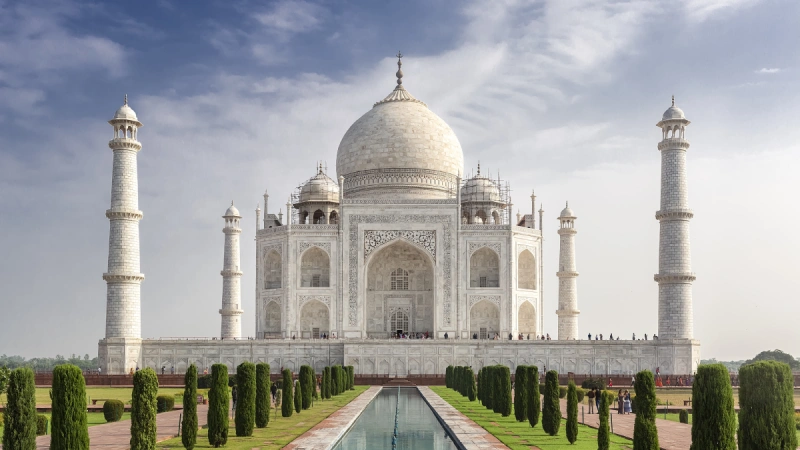The Taj Mahal is not just a monument; it’s a treasure trove of history, culture, and architectural brilliance. While most people know it as a symbol of love, there are many lesser-known facts and insights that make the Taj Mahal even more fascinating. In this guide, we’ll explore the hidden stories, historical context, and intriguing details that every history enthusiast should know. Whether you’re planning a visit or simply curious, these insights will deepen your appreciation for this iconic wonder.
The Historical Context of the Taj Mahal
The Taj Mahal was built during the Mughal Empire, a period known for its architectural marvels and cultural richness. Emperor Shah Jahan commissioned the monument in 1632 in memory of his beloved wife, Mumtaz Mahal. The Mughals were known for their love of art, symmetry, and grandeur, and the Taj Mahal is a perfect example of their architectural prowess.
The monument was designed by a team of architects, including Ustad Ahmad Lahauri, who is often credited as the chief architect. Over 20,000 artisans, including calligraphers, stonecutters, and inlay artists, worked on the monument. Many of these craftsmen were brought from Persia, Turkey, and India, showcasing the multicultural collaboration behind the Taj Mahal.
Lesser-Known Facts About the Taj Mahal
One of the most fascinating aspects of the Taj Mahal is its ability to change colors throughout the day. The monument appears pinkish in the morning, white during the day, and golden at night. This phenomenon is due to the reflection of sunlight on the white marble.
There’s a popular myth that Shah Jahan planned to build a black marble mausoleum for himself across the Yamuna River, mirroring the white Taj Mahal. However, historians believe this is more fiction than fact, as there’s no concrete evidence to support this claim.
The walls of the Taj Mahal are adorned with intricate calligraphy featuring verses from the Quran. The size of the letters increases as they go higher, creating an optical illusion of uniformity. This calligraphy was designed by Amanat Khan, a master calligrapher.
The Construction Secrets
The white marble used in the Taj Mahal was brought from Makrana in Rajasthan, over 300 kilometers away. Other materials, such as jade from China, crystal from Tibet, and sapphires from Sri Lanka, were sourced from across Asia. The total cost of construction was around 32 million rupees, equivalent to over $1 billion today.
Over 20,000 workers, including skilled artisans, laborers, and craftsmen, were involved in the construction of the Taj Mahal. The project took approximately 22 years to complete, from 1632 to 1654.
The Taj Mahal’s foundation is made of wooden supports, which were designed to withstand the test of time. However, the drying up of the Yamuna River has led to cracks in the foundation, posing a significant threat to the monument’s structural integrity.
The Symbolism Behind the Taj Mahal
The Taj Mahal is often called the “Monument of Love” because it represents Shah Jahan’s eternal love for Mumtaz Mahal. It is a testament to the power of love and devotion, making it a popular destination for couples and romantics.
The Taj Mahal’s design is inspired by the Islamic concept of paradise. The gardens, water channels, and symmetrical layout are all symbolic of the gardens of paradise described in the Quran.
The four minarets at each corner of the Taj Mahal are slightly tilted outward. This design was intentional, as it prevents the minarets from falling onto the main tomb in case of an earthquake.
The Challenges of Preservation
The Taj Mahal’s white marble is turning yellow due to air pollution and the deposition of dust and particulate matter. Conservationists use mud pack therapy to clean the marble and restore its original shine.
Insects from the polluted Yamuna River leave green and black stains on the marble. Efforts are being made to clean the river and reduce the insect population.
Millions of visitors each year contribute to wear and tear, especially in high-traffic areas. To address this, authorities have implemented measures such as limiting the number of visitors per day and restricting access to certain areas.
FAQs About the Taj Mahal’s History
Who built the Taj Mahal?
The Taj Mahal was built by Mughal Emperor Shah Jahan in memory of his wife, Mumtaz Mahal.
How long did it take to build the Taj Mahal?
The Taj Mahal took approximately 22 years to complete, from 1632 to 1654.
What materials were used in the construction of the Taj Mahal?
The white marble was brought from Makrana in Rajasthan, and other materials, such as jade, crystal, and sapphires, were sourced from across Asia.
Why is the Taj Mahal turning yellow?
The Taj Mahal’s white marble is turning yellow due to air pollution and the deposition of dust and particulate matter.
What is the significance of the four minarets?
The four minarets are slightly tilted outward to prevent them from falling onto the main tomb in case of an earthquake.
Conclusion
The Taj Mahal is more than just a monument; it’s a living testament to history, love, and architectural brilliance. By exploring its lesser-known facts and historical context, we can deepen our appreciation for this iconic wonder. Whether you’re a history buff or a curious traveler, these insights will enrich your understanding of the Taj Mahal and its enduring legacy.

